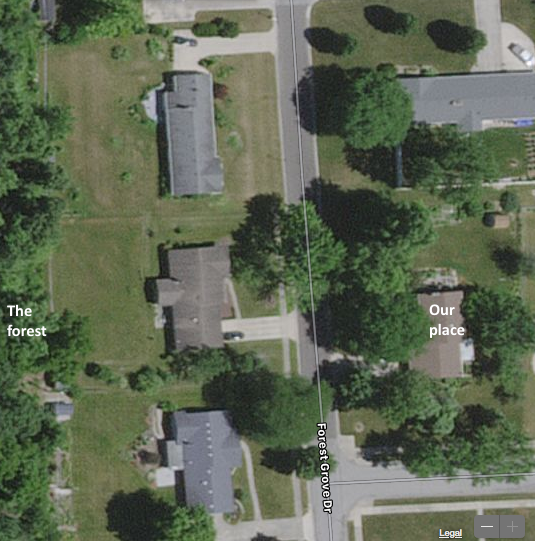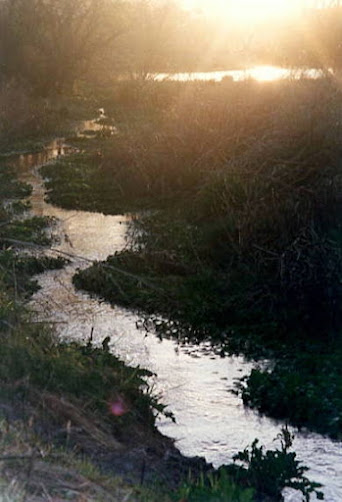Places for the heart and soul to grow
 |
| A small creek in the midwest |
When I was 7 years old, my family moved from a brick bungalow on the south side of Chicago to a ranch-style house in a suburban cul de sac in Ft. Wayne, Indiana. Everything about our new neighborhood was very different than our old one (which I missed so much), except for one very special thing: our small Chicago house on a
small urban lot was across the street from a giant easement of open meadow, wetland, and
trees, with freight rail tracks running down the middle of it. All us kids called it "the prairie", and it was filled with the magical sights and sounds of dragonflies, songbirds,
lightning bugs, and frogs. How I longed to venture out there, but because it was also a place where teens and young adults met to hang out, build fires, and fight, it was off limits to me (but not to my big brothers). However, the backyard of our new house had a "prairie" right behind it too, with hundreds of acres of farm fields and a tree-lined creek. This wonderfland was not off limits for me, so I spent countless hours roaming it in all kinds of weather. The main danger we kids were scared of there was being chased off by an angry farmer, which made us learn how to steal blueberries from the "secret side" of the hedgerow, run silent through the corn, and quickly jump over rows of soybeans to get to the trees and creek. In summer, we waded barefoot through the cool murky waters looking for crawdads, and sat in the shade of the high muddy bank looking up at the slice of clear blue sky overhead. In winter, we trudged through the snowy fields all bundled up,
scrambling down the slippery bank to try to skate, even though that
meant frequently tripping over branches and other debris sticking up
through the thin ice. Those experiences are deeply etched in my heart and soul, and I can still see those scenes clearly in my mind's eye today.
When I was 10, my parents had their "dream home" built in a suburban development on the other side of town, complete with a separate but connected apartment for my grandparents to live in. New streets and houses filled land where there had once been a farm, and our half-acre lot at the very edge of the development had recently been a field of corn or soybeans. Other than two
small ash trees along one side of our property line, our big new
house was surrounded by a sea of lawn, like most others on the block. But just beyond it stretched another "prairie" of fallow farmland that had become a tall meadow, a giant dirt hill from a Kroger store's construction, and a small creek. Butterflies, dragonflies, lightning bugs, spiders, and bees abounded throughout, and my first two summers of meadow adventures left an indelible mark on my life. Little by little after that, new houses with big green lawns took the place of that "prairie", and even the giant hill was removed. However, across the street from our house, somehow left untouched by a century of farming, was a treasure that still stands today: dozens of acres of forest land. This shady oasis was filled with browsing deer, rabbits, raccoons, squirrels and chipmunks, songbirds, frogs, and an occasional fox, and being able to spend many adolescent and teen days there was a gift that I will always cherish. I still remember so clearly the sound of the dry autumn leaves under my feet, seeing the bare trees silhouetted by the blazing winter sunsets, the brilliant green buds of spring, and the shimmering emerald leaves of summer.
After we had lived in the house for a short time, my father
started spending his Saturday mornings digging up tiny saplings from the
forest. They were mostly oaks and maples, all were nothing but little
sticks with barely a side branch, and I’m not sure how (or if) he knew
what species they were when he brought them home. Perhaps my father, growing up in 1930's south Chicago, also had some nature close to home where he learned about trees, and that he never told us about.
Or perhaps living across the street from that little forest made him
become a tree lover. He also went to a local nursery and bought tiny
crabapple and magnolia trees, apple and peach trees, a locust, and my
favorite: an Eastern Redbud planted next to the front porch. I watched
him dig holes in the sticky yellow clay soil over and over, and
helped him plant and stake 25-30 of the "little sticks", yet I couldn't
really understand at that age that he was planting a small forest around
the entire property. Only the view from my
grandparents' apartment was left open, because my grandma insisted that she always be
able to see out into the surrounding fields and have sunshine on her
flower beds.
 | ||
| My parents with "my" locust tree in 1995. |
 In 1989, the 47-acre forest across the street was acquired by a non-profit called ACRES Land
Trust, and named the Mengerson Nature Reserve. A loop trail passes though an open wildflower meadow and then under towering sugar maples and oaks, hickory and hawthorn trees, with scores of smaller dogwoods, elms, and beech trees. It makes my heart so happy that this oasis remains a wonderful
place where all are welcome to wander into the peace and beauty of nature. I hope to visit it again someday too. For more information, visit https://acreslandtrust.org/preserve/mengerson-nature-reserve
In 1989, the 47-acre forest across the street was acquired by a non-profit called ACRES Land
Trust, and named the Mengerson Nature Reserve. A loop trail passes though an open wildflower meadow and then under towering sugar maples and oaks, hickory and hawthorn trees, with scores of smaller dogwoods, elms, and beech trees. It makes my heart so happy that this oasis remains a wonderful
place where all are welcome to wander into the peace and beauty of nature. I hope to visit it again someday too. For more information, visit https://acreslandtrust.org/preserve/mengerson-nature-reserve |
| A 2018 day at Magnuson Children's Garden |
Photo credits:
- Illinois creek by J.Pinta, Creative Commons Attribution-Share Alike 3.0 Unported license
- Aerial photos by Google Maps
- Locust tree by Emily Bishton
- Mengerson Reserve by ACRESLandTrust.com
- Magnuson Children's Garden scene by Sara Kovacs




